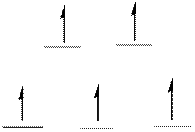
Concept explainers
(a)
Interpretation:
Using crystal field theory, the energy level diagram of d-orbitals of the complex ion
Concept Introduction:
There are five d-orbitals in a metal ion. They have similar energy levels that they are degenerated. Under the influence of ligands during complex formation, the degeneracy in d-orbitals is destroyed that they are split into two sets of orbitals - one set having lower energy and the another set is higher in energy. Crystal field splitting refers to the difference in energy levels between these two sets of d-orbitals.
When ligands approach the metal ion the degeneracy in d-orbitals of the metal ion is destroyed and they split into two different energy levels. In case of octahedral complex, the
(a)
Answer to Problem 22.58QP
The energy level diagram of d-orbitals of the complex ion

Two unpaired electrons are present in this complex ion.
Explanation of Solution
The electronic configuration of

(b)
Interpretation:
Using crystal field theory, the energy level diagram of d-orbitals of the low-spin complex ion
Concept Introduction:
There are five d-orbitals in a metal ion. They have similar energy levels that they are degenerated. Under the influence of ligands during complex formation, the degeneracy in d-orbitals is destroyed that they are split into two sets of orbitals - one set having lower energy and the another set is higher in energy. Crystal field splitting refers to the difference in energy levels between these two sets of d-orbitals.
When ligands approach the metal ion the degeneracy in d-orbitals of the metal ion is destroyed and they split into two different energy levels. In case of octahedral complex, the
(b)
Answer to Problem 22.58QP
The energy level diagram of d-orbitals of the low-spin complex ion

The low-spin complex ion
Explanation of Solution
Atomic number of Osmium is
The electronic configuration of

From the above arrangement we could say there are two unpaired electrons in the complex ion
(c)
Interpretation:
Using crystal field theory, the energy level diagram of d-orbitals of the high-spin complex ion
Concept Introduction:
There are five d-orbitals in a metal ion. They have similar energy levels that they are degenerated. Under the influence of ligands during complex formation, the degeneracy in d-orbitals is destroyed that they are split into two sets of orbitals - one set having lower energy and the another set is higher in energy. Crystal field splitting refers to the difference in energy levels between these two sets of d-orbitals.
When ligands approach the metal ion the degeneracy in d-orbitals of the metal ion is destroyed and they split into two different energy levels. In case of octahedral complex, the
(c)
Answer to Problem 22.58QP
The energy level diagram of d-orbitals of the high-spin complex ion

There are five unpaired electrons in the complex ion
Explanation of Solution
Atomic number of Manganese is
The electronic configuration of

From the above arrangement we could say there are five unpaired electrons in the complex ion
Want to see more full solutions like this?
Chapter 22 Solutions
General Chemistry - Standalone book (MindTap Course List)
 ChemistryChemistryISBN:9781305957404Author:Steven S. Zumdahl, Susan A. Zumdahl, Donald J. DeCostePublisher:Cengage Learning
ChemistryChemistryISBN:9781305957404Author:Steven S. Zumdahl, Susan A. Zumdahl, Donald J. DeCostePublisher:Cengage Learning
 Chemistry: An Atoms First ApproachChemistryISBN:9781305079243Author:Steven S. Zumdahl, Susan A. ZumdahlPublisher:Cengage Learning
Chemistry: An Atoms First ApproachChemistryISBN:9781305079243Author:Steven S. Zumdahl, Susan A. ZumdahlPublisher:Cengage Learning Chemistry: The Molecular ScienceChemistryISBN:9781285199047Author:John W. Moore, Conrad L. StanitskiPublisher:Cengage Learning
Chemistry: The Molecular ScienceChemistryISBN:9781285199047Author:John W. Moore, Conrad L. StanitskiPublisher:Cengage Learning Chemistry: Principles and PracticeChemistryISBN:9780534420123Author:Daniel L. Reger, Scott R. Goode, David W. Ball, Edward MercerPublisher:Cengage Learning
Chemistry: Principles and PracticeChemistryISBN:9780534420123Author:Daniel L. Reger, Scott R. Goode, David W. Ball, Edward MercerPublisher:Cengage Learning Chemistry & Chemical ReactivityChemistryISBN:9781133949640Author:John C. Kotz, Paul M. Treichel, John Townsend, David TreichelPublisher:Cengage Learning
Chemistry & Chemical ReactivityChemistryISBN:9781133949640Author:John C. Kotz, Paul M. Treichel, John Townsend, David TreichelPublisher:Cengage Learning





